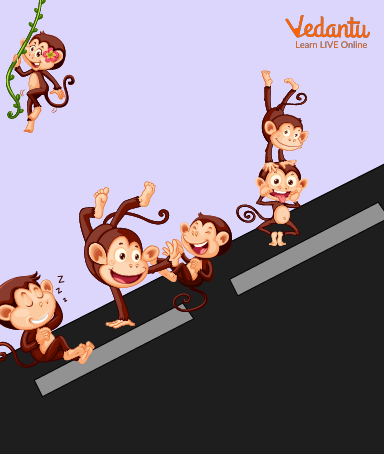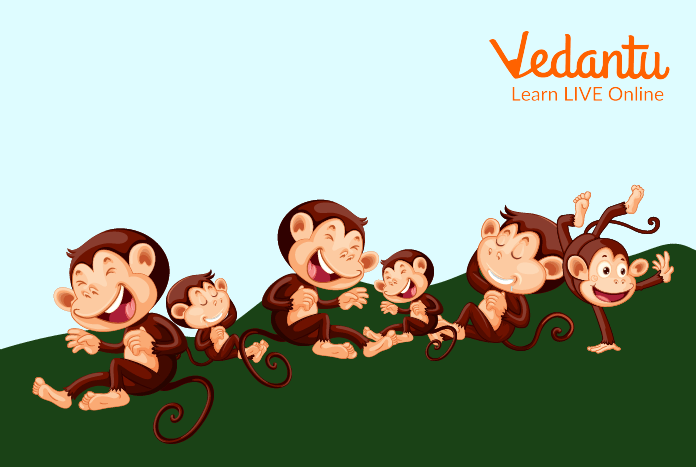




Introduction
Have you ever seen monkeys on the roadside, on top of trees, on roofs of other people's houses and wondered where monkeys are supposed to live? Where is their home? In this article, we will get to know the answers of all these questions. We will learn about where monkeys live, what their preferred habitat is, what they eat, and some other interesting facts.

Monkeys Sitting on the Roadside
A habitat is a place where an organism settles down and makes its home. It includes various environmental factors like food, shelter, optimal temperature, etc., which suit an organism and increase its chances of survival and reproduction.
What is Monkey Habitat?
Naturally, monkeys prefer to live in the trees of the rainforest as it's the most suitable environment or habitat for them. They are found everywhere except on the continent of Australia and Antarctica.
Unfortunately, due to human invasion, many of the forests which are home to monkeys are destroyed, invaded, and divided due to human settlements. It all has caused a habitat change and adaptations to other extremes for living. As the monkeys lose their beloved habitat they start settling on roads, at human homes, temples, etc. as they get easy access to food and shelter for their survival there.
What Do Monkeys Eat?
Monkeys mostly are known as lovers of bananas as they are mostly portrayed as banana eaters from every nursery rhyme to cartoons. But in natural conditions, monkeys are omnivores, they eat plant-based food such as seeds, fruits, etc. but can also eat small insects, bird eggs, etc. Moreover, monkeys change their eating habits according to seasonal variations.

Rat-eating Monkey
Groups of Monkeys
Monkeys usually prefer to stay in groups and are clever, and social animals. Usually, the group of monkeys is led by a male monkey that leads all the females and their children and if another male monkey has to add on to the group, he may have to fight the leader and prove himself fit to be added.

Group of Monkeys
Interesting Facts and Information About Monkeys
There are about 200 species of monkeys all around the world. There are 14 species of monkey existing in India most common of them are namely macaques, langurs, looses, and gibbons. Different species of monkeys can greatly vary in size, habitat, social behaviour, and eating habits. The largest and most colourful monkey species are Mandrills.

Mandrill Monkey
Monkeys mostly use all four of their limbs to walk and climb. They have a coat of fur on their body that protects them from extreme seasonal variations whereas most of them have bare areas of exposed skin without hair too like the buttocks and face. Monkeys are great problem solvers and also considered intelligent. That is why we can see that the first mammal that went to space was a rhesus monkey.
Conclusion
Monkeys are a very diverse and interesting group of mammals. They share a common ancestor with humans as well as apes. There are varieties of monkeys all over the world having unique qualities from having various colours, and sizes but on a broad scale, they are very social, intelligent, and clever.
FAQs on Where Do Monkeys Live?
1. Are monkeys carnivores?
Yes, monkeys can be carnivores. Monkey species like baboons and capuchins are the most ferocious meat-eaters; they can eat snakes, rabbits, fishes, etc. Despite these, other monkey species are omnivorous and change their eating habits with respect to environmental conditions and habitat they are in and what source of food is easily available. They can eat seeds, fruits like coconut or banana, plants, and leaves, or can also eat small insects like ticks, and animals like hares or rats that are easy to acquire.
2. Are monkeys dangerous to humans?
Monkeys usually do not harm humans until they are disturbed by human activities like scaring them, and throwing pebbles at them. If threatened, monkeys can bite humans and can cause serious wounds. Apart from that, monkeys are also carriers of various harmful diseases like the Herpes virus which can prove to be deadly and can take multiple lives. Monkeys are usually kept by small-wage workers to entertain and earn money by training them in India yet it is preferred not to get a bite from them.
3. Can we keep monkeys as pets?
Monkeys are legalised to be kept as pets in various countries but they are not very suitable to be kept as pets because they can be aggressive and can harm children and people around them and if kept unhygienic and unchecked can cause various diseases. Once a man kept a monkey and fed it and loved it, yet on attaining maturity, the monkey became aggressive and bit the man and the man got 24 stitches on his hand. This shows that one should always beware of the behaviour of monkeys.









